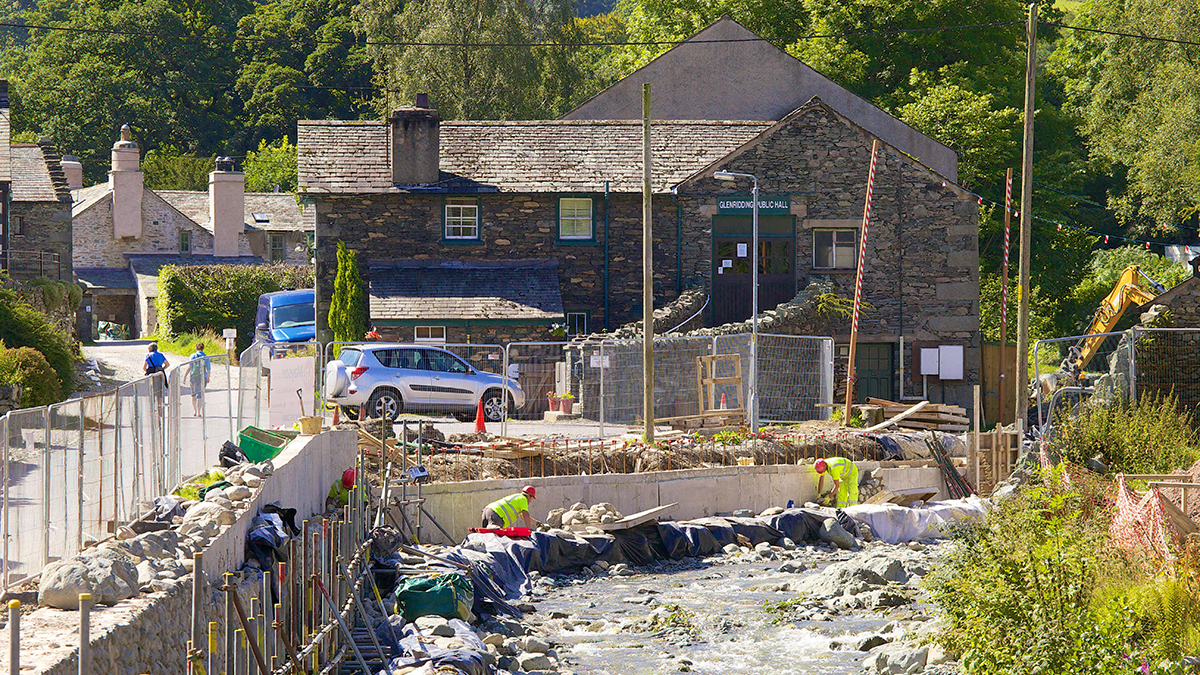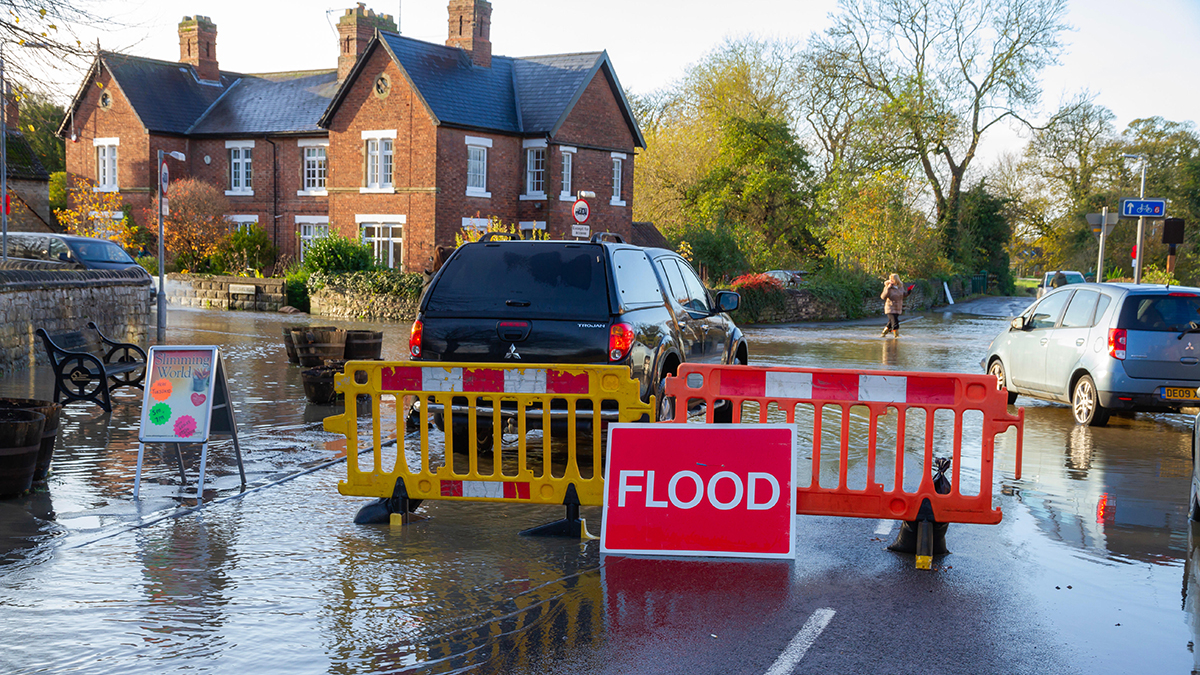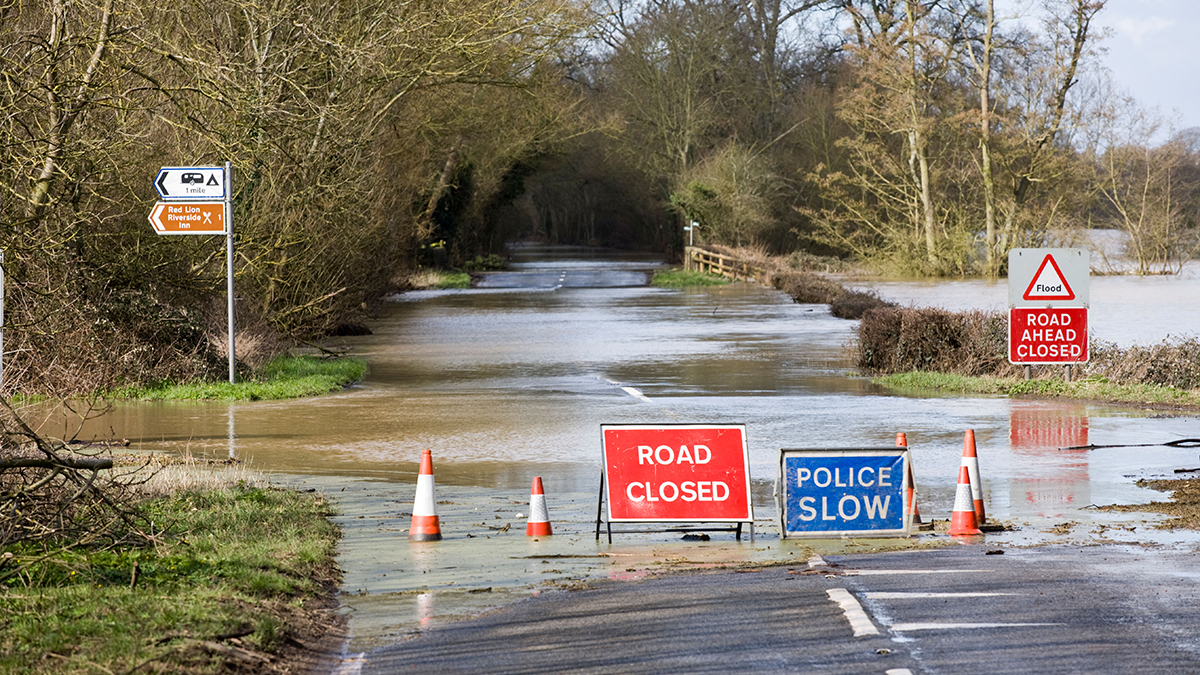'The UK has had near misses on major flood losses': Flood Re's Bord
‘Just because we happen to have had a benign period – and, in fact, our results for the last year reflect that – shouldn't give us comfort,’ Flood Re’s chief executive, Andy Bord, says
Flood Re chief executive discusses the progress of the Build Back Better initiative, the development of flood performance certification and measuring the non-for-profit scheme’s legacy
Flood Re has explained its fall in profit as being the result of a “benign” year for flood events, but its chief executive, Andy Bord, stresses this does not mean the risk of flooding has changed.
In an interview with Insurance Day, Bord says the UK has had some “near misses”, while recent weeks have provided ample evidence of the growing impact of climate change. “There hasn’t been a huge amount of evidence over recent years of direct climate change-related flooding in the UK,” he says.
“In fact, the last major events were storms Ciara and Dennis, in the 2019/20 season. We absolutely have seen flooding since then but actually what we’ve had is a number of near misses where weather systems have moved and hit parts of continental Europe really hard but could equally have made landfall in the UK.
“Just because we happen to have had a benign period – and, in fact, our results for the last year reflect that – shouldn’t give us comfort,” he adds.
 Flooding in Dimapur, Nagaland, India this month shows floods are ‘more and more frequent and more and more severe’
Caisii Mao/Alamy Stock Photo
Flooding in Dimapur, Nagaland, India this month shows floods are ‘more and more frequent and more and more severe’
Caisii Mao/Alamy Stock Photo
Footage of recent flooding in Zaragoza, Spain showed cars being rammed into homes within an hour of the flood event starting, Bord says. In northern India, he continues, more than 40 people died recently as the result of another flash flood event, “so these things are happening, they are becoming more and more frequent and more and more severe and that’s what climate change will continue to create”, he says.
Flood Re recorded a profit before tax of £110m ($142m) for the year to the end of March 2023, which was down from £132m in the previous financial year. It incurred gross claims of £45.9m, up from £32.1m. “Our profits continue to be quite high given we are not-for-profit but that reflects the fact we haven’t had a big event on which we’ve had to pay out on. Clearly, we’ve had to maintain our own reinsurance programme, but that’s what we mean by a ‘benign’ year,” Bord says.
Defining flood risk
The definition of flood risk differs between organisations and the correct source for this in the UK is the Environment Agency, not Flood Re. The Environment Agency defines a high risk of flooding as greater than a one-in-30 probability in any one year. Medium risk is a one-in-100 probability and low risk less than one in 100.
“From Flood Re’s perspective, it doesn’t really matter what the flood risk is because the way we’re set up is that this is very deliberately an insurer’s decision as to whether to pass the individual household flood risk across to us or not,” Bord says.
“We are obliged to take any risk that is ceded to us because different insurers will have different perspectives on the risk of that individual property, regardless of how they appear on an Environment Agency map.”
Flood Re was created in 2016 as a joint industry- and government-sponsored scheme to enable the continued availability of affordable cover for households at risk of flooding. Crucially, it was tasked with managing the transition to a market with risk-reflective pricing over a 25-year period. It has been doing this by providing insurers with the ability to purchase subsidised reinsurance from Flood Re through a commercial arrangement.
Flood Re will, by statute, cease to exist in 2039.
Bord describes the not-for-profit organisation’s purpose as twofold. First, it is a reinsurance solution to the problem of residents at high risk of flooding either finding they could not access home insurance or, if they could, it was unaffordable. Second, it is helping insurers to transition such that, when Flood Re leaves the market, they will still be able to access the information they need to cover flood risk. “It will be a collective failure if, when we exit, there isn’t an effective, functioning market that enables people at risk of flooding to access home insurance,” Bord says.
“It will be a collective failure if, when we exit, there isn’t an effective, functioning market that enables people at risk of flooding to access home insurance”
Andy Bord
Flood Re
For Flood Re to be deemed successful, three things must be true, he continues. Flood risk needs to continue to be managed beyond 2039, which means building the required defences; designing, building and adapting homes to the right standards; and there has to be an effective market.
To help achieve this, in April 2022 Flood Re launched its Build Back Better scheme, which is designed to reduce the cost and impact of future floods by including property resilience measures as part of flood repairs.So far, two-thirds of the UK market by gross written premium have signed up to the scheme, Bord says.
“We’ve got 13 insurers signed up and the number continues to grow. The important bit for me is looking beyond that number, which is I want Build Back Better to be a standard part of any household policy,” he says.
That is achievable if the industry “moves quickly and together” and it needs to be “assumed to be the standard”, just as a “new-for-old” policy is at present, for example, on contents insurance.
Bord says: “It’s crazy to put a home back into the same state if it’s still at risk of flooding and then expecting a different outcome next time. Build Back Better is an ideal opportunity to improve the resilience of the housing stock.”
Build Back Better is a voluntary scheme, but Bord wants to see it “normalised” so it becomes standard in every policy, meaning an insured is put back not into the same state they were before, but into a more resilient one.
Flood risk scoring
Flood Re is also driving forward its plan for the UK to have flood performance certificates. Eventually, every UK home up for sale or rent should have one, Bord says, just as they have been required, since 2007, to have an energy performance certificate.
Flood Re has piloted flood performance certificates in East Peckham, a village in the English county of Kent.
Bord says these certificates will be an assessment of a residential property’s protection against the risk of flooding, together with a list of mitigating measures that are already in place, such as sealable air brick covers, water-resistant flooring and flood-proof doors. Importantly, a flood performance certificate will also say what steps could be taken to make the property even better protected against flood risk.
To better understand the benefits of these individual measures, Flood Re is formulating a “scoring methodology”, not only to help insurers but also anyone in the “flood industry”, Bord says.
He continues: “We’re hoping the benefits will be compelling for house developers but, equally, at a local authority level, if you’ve got a high flood risk area, it’s beneficial for as many people as possible to have flood performance certificates in place, particularly for people who are buying, selling or renting their home. We still need to work through the detail and encourage government to take its appropriate place in that as well, and make sure insurers understand the benefits of using them.”
Having flood performance certificates will dispel the myth, Bord says, that flood defences are an indication of an underlying problem. “Having flood defences was seen as a negative because it drew attention to the fact there was a risk, but that’s completely turning on its head now and seen as absolutely positive,” he says.
“Flood risk is evident, because it’s more widely reported and therefore it’s important to have that benefit properly assessed and accredited. And we believe flood performance certificates are the right way to do that.”
Flood Re is also pushing ahead with its new idea to have a “centre of excellence”. Bord says: “We recognise flooding is an inherently complicated topic and responsibility and accountability for that is spread across many areas, in both the private and the public sector. We’re uniquely placed at the centre of the insurance industry for residential property and what we want to do is increase the ability to access knowledge that isn’t currently there, to build that knowledge infrastructure.”
Examples this centre of excellence could follow are the Thatcham Centre for motor insurers’ automotive research and the Fire Protection Agency.
Bord continues: “Where there is a particular industry need to better understand a peril, this is a great way to pull different sources of information together. And our purpose is that it will help to accelerate that knowledge development and therefore the action that needs to be taken, so we’re better able to exit the market in 2039 and there still to be the ability for the market to access affordable and available home insurance if you’re at risk of flooding.”
On the form the centre of excellence will take, Bord says it is important to avoid duplication of effort. “We don’t want to replicate anything that already exists, so we’re taking our time. While recognising the urgency of what we need to do, we’re being really focused on what will make the maximum difference. That’s the investigative stage we’re in at the moment.”
Would the centre of excellence be a legacy for Flood Re? “Our intention is this gets up and running quite quickly. We haven’t set timescales around that yet, but it could well be that it will coexist with Flood Re and potentially be a legacy for us. That will become clearer in the coming months,” Bord says.
Who will supervise the centre of excellence has also yet to be decided, he adds.
Impact of inflation
In its 2022/2023 accounts, Flood Re says it was successful at mitigating the impact of inflation. Bord says there are two elements to this success.
The first is inflation that directly affects consumers through cost-of-living challenges. “The mere existence of Flood Re makes a very positive contribution to households that are at risk of flooding because it makes their home insurance cheaper, whereas potentially it wasn’t affordable at all,” Bord says.
The second is how Flood Re has been changing its approach to investments. Bord says: “We went through our last statutory review process such that we could change our investment approach, so we’re able to obtain a better return on the money we hold to mitigate some of the impacts inflation would otherwise have corroded. We also increased our premiums in April 2023, at the start of this financial year. We increased them by significantly less than the rate of inflation, so, again, good news from a consumer perspective. Everything we do – and that’s the advantage of being a not-for-profit – is centred on driving that affordability objective.”
Flood Re raises a levy every year on the insurance industry. Before April 1, 2022 Flood Re used to set the levy every five years but on April 1, 2022 it reduced the levy from £180m to £135m for a three-year period.
The Build Back Better scheme, new levy and new approach to investments all followed the conclusion last year of Flood Re’s first quinquennial review with the government. “We looked at the exposure we’re carrying, the number of properties, the amount of income we’re raising and we were content actually we didn’t need to maintain the levy at £180m and could reduce it to £135m for the next three-year period and also align it to our outward reinsurance purchase,” Bord says.
“My biggest cost is the reinsurance that I buy and by aligning the levy, which is the main part of our income to that, it makes the scheme work much more effectively. So, it’s a long-term reset that we did. And this was the first year of that lower income.”
Following that review, the government also allowed Flood Re to set its liability limit every three years instead of every five. As previously agreed, the liability limit is £1.9bn for the three-year period from 1 April 2022 and Flood Re has procured reinsurance on this basis.
Since its launch in 2016, more than half a million households have benefited from a Flood Re-backed policy. In 2022/23 it backed 265,826 policies, a 3.6% increase on the previous year.
“We have no target for the number of policies,” Bord stresses. “We describe it as a dynamic scheme that responds to the economic conditions that are prevailing: both the economic conditions for insurers and the economic conditions that affect affordability. We don’t have a particular growth target and we don’t have a particular target in terms of customer numbers.
“Our measure of success is how many customers are able to access affordable home insurance. And we’ve seen in the year we’re reporting on, 99% of people at risk of flooding can obtain 15 or more quotes. Before Flood Re existed, only 9% of people could get two or more quotes, so it continues to be transformational for people at high risk of flooding.”
Successes
Bord highlights two of Flood Re’s successes. “Now anyone can access affordable home insurance, even if they’re at risk of flooding, and if they have been flooded before that doesn’t count against them either. That’s a massive success for the scheme and it’s exactly what we were set up to do,” he says.
The Build Back Better scheme has been “equally transformational” and is Flood Re’s second main success.
Bord says: “If you look at a situation insurance is based on, where you put a home back into the same state as it was beforehand, that’s great if you’ve had an accidental fire or a spillage or something like that, but if you’ve been flooded – and we know, because of climate change, it’s going to be more frequent and more severe – and you just put the home back into the same state and cross your fingers and hope it will be all right, that’s the definition of madness.”
He continues: “Whereas, if you invest and deliberately put that home back, where appropriate, into a better protected and more resilient space that keeps the water out and, where it does get in, makes it easier to recover the home, that makes a massive impact.”
In terms of what Flood Re has left to do is summed up by its recently published transition plan.
“As a matter of law, we need to be able to exit and make sure the market still functions without the cross-subsidy we administer, so if you are at risk of flooding then you still have access to affordable home insurance without Flood Re. That’s what success will look like by 2039,” Bord says.
The challenges that remain can be described, he says, as headwinds: climate change and inappropriate development of housing. “As a country and as a society, we need to run faster, both to reduce the risk of climate change and stop making it worse through carbon emissions, and the second is just adapting faster. That’s why we at Flood Re have been particularly vocal that we need to continue to invest in flood defences, continue to make homes better protected and continue to make sure there’s an effective market that underpins those. So, climate change is the first headwind.
“The second is inappropriate development, either building homes in the wrong place or in the wrong way just makes the problem worse. We’ve got to make sure we don’t make the problem worse.”



